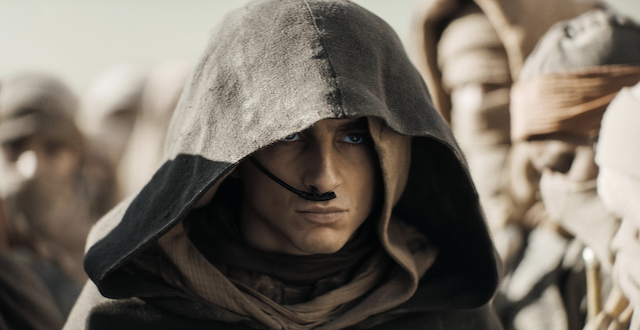
Photo by Niko Tavernise/Niko Tavernise – © 2022 Warner Bros. Pictures
Dune: Part Two will explore the mythic journey of Paul Atreides as he unites with Chani and the Fremen while on a warpath of revenge against the conspirators who destroyed his family. Facing a choice between the love of his life and the fate of the known universe, he endeavors to prevent a terrible future only he can foresee.
Rating: PG-13 (Sequences of Strong Violence|Brief Strong Language|Some Suggestive Material)
Genre: Sci-fi, Adventure, Action, Fantasy, Drama
Original Language: English
Director: Denis Villeneuve
Producer: Mary Parent, Cale Boyter, Denis Villeneuve, Tanya Lapointe, Patrick McCormick
Writer: Denis Villeneuve, Jon Spaihts
Release Date (Theaters): Wide
Runtime:
Distributor: Warner Bros. Pictures
Production Co: Legendary Pictures
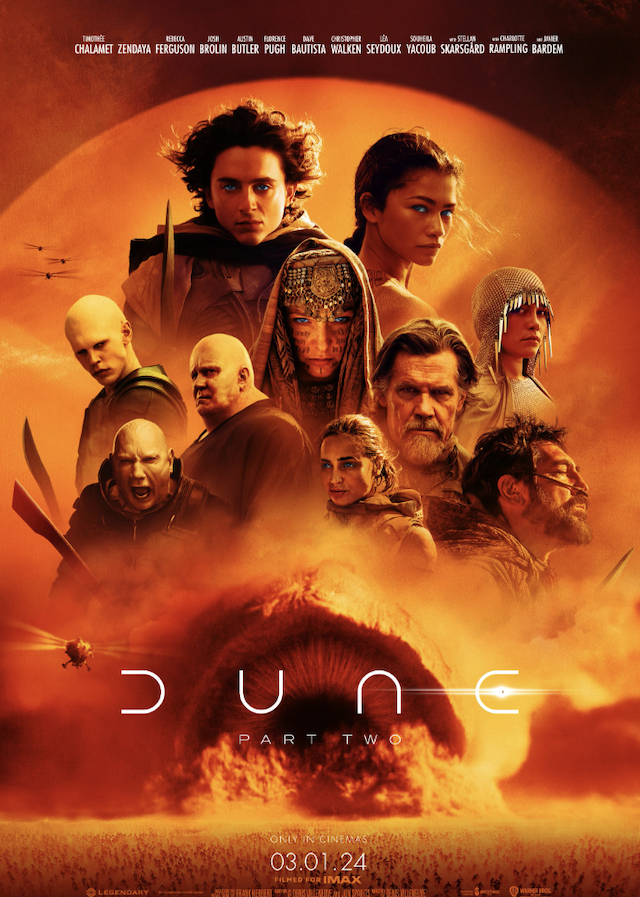
Press Conference with Director Denis Villeneuve
Q : How significant has it been to reintroduce the crew from the first chapter?
Denis Villeneuve: It was important for me to bring as many people as possible from part one. People that knew everything about the world, we had just created. It was the first time that I was revisiting a world, working with the same partners meant that everybody knew exactly what I was aiming for aesthetically, they knew my cinematic vocabulary.
Patrice Vermette, the production designer, had already started to design the movie while we were doing the first one. It was like taking extra time and imagining what could be in the future. In some ways Part Two was already a work in progress, pre-production was quite intense because we were in the award season and it was a bit more compressed than the previous one.
For the first Dune, I had more time to do research and development. But because we did our own work correctly, there were a lot of things that we know, like for example the behavior of a sandworm under the sun, or the look of the sandworm. We used the computer software that was designed for the first Dune, we had a big toolbox that was available, so it allowed us to go a bit faster. That is why I was aiming for the movie to come out in November. The movie was ready on time.
Q : Do you feel Dune: Part Two is going to be a cinematic experience for a generation?
Denis Villeneuve: Those are the movies that created the spark in me to become a director, the movies that embrace the power of the white screen and that immerse yourself in their world. I’m absolutely in love with the theatrical experience and I’m trying the best I can to make movies that will find all their full power in a theater.
All my movies have been written, designed, shot, edited, thinking about the white screen. And of course the sound design is something that is quite important. Maybe in the future the television will get better and better with the VR experience, maybe you will have some screen that could fill your field of vision.
But it’ll never add the definition or the sound will never be like in a theater where you need space, you need oxygen around you in order to create that pressure on the idea, that impact.
Q : In writing and directing Dune: Part Two, what did you keep in mind to make the film epic and spectacular and yet create this emotional heartbeat?
Denis Villeneuve: Creating the epic and the action is not that difficult to do. What is difficult to do is to make sure that we don’t lose focus on the intimate relationship, the story between Paul and Chani. That’s the heartbeat of the movie, their relationship unfolds all the drama of the film.
Through the eyes of Chani and Paul, we feel the political pressure, the cultural pressure, the oppression. I really constructed the movie focused on the tension between them. I kept saying to my crew, “If we don’t believe in their relationship, we don’t have a movie.” And that was my main focus during the whole shooting, to take care and to be as close to them as possible.
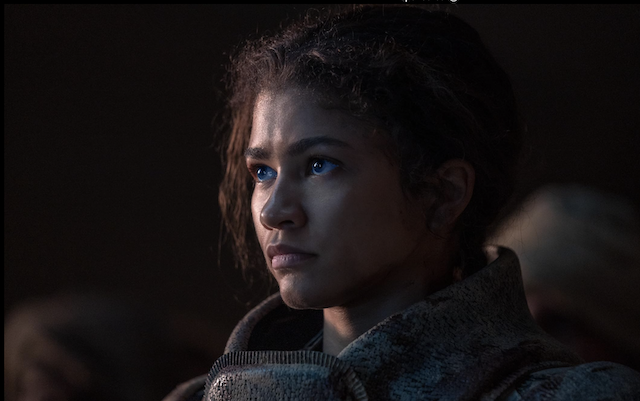 Photo by Niko Tavernise/Niko Tavernise – © 2022 Warner Bros. Pictures
Photo by Niko Tavernise/Niko Tavernise – © 2022 Warner Bros. Pictures
Q : Can you talk about how you worked with your actors to bring out the complexity of those relationships on screen?
Denis Villeneuve: I don’t know exactly how to answer this question. I will say that it’s my job to make sure that I will create an environment around the camera that will be suitable, that will be as best as possible to bring concentration and focus so that the actor feels protected, safe. I’ve been told many times by actors that they feel almost like we are doing an indie movie, meaning that there’s a feeling of family around the camera, like an intimacy.
I’m trying to protect them and I’m trying to make sure that the actors never feel the pressure of the big machine. That’s my job, I have big shoulders and I can deal with it. I really try to make sure that they can have the necessary space to connect with the emotion that I need to capture on camera. It’s the reason we built sets, we try to go as much as possible on location in order to be surrounded by elements, things that create a reality around them. The actors can take everything around them for granted. It’s there, it’s real, and they can just focus on their relationship and inner development of their own character.
Q : Paul riding the sandworm is an important scene. How did seeing Timothy riding it compared to what you had imagined and invented? What was that like seeing that come to life?
Denis Villeneuve: That scene is my deep, pure joy. It is exactly how I dreamed it. It was by far the most complex thing I have ever attempted to do. It required a lot of work, in order to achieve that level of realism. I wanted my mother to believe that it’s possible to ride a sandworm. I wanted it to be edgy, elegant, dangerous, exciting.
It required a tremendous amount of work from my crew to be able to bring that to the screen. But fortunately, we all knew that the studio believed in the scene a lot and they gave me the means and the tools to do it correctly.
Q : How daunting was it to create a new language for the characters with Dune and how did you actually go about inventing the dialect for them?
Denis Villeneuve: When we did Part One, there was a little bit of the language of the Fremen, we heard it from Javier Bardem’s character, Stilgar. We hired a specialist in language, a linguist. David Peterson. He had worked previously on Game of Thrones. Frank Herbert did put in the book some of the language, we developed it.
David expanded the language according to the dialogues I had written with Jon Spaihts. He really created a full language with a full vocabulary, with a full syntax, grammatical structures, and full logic. Then Davi taught the actors with a video about the pronunciation, how to pronounce each word, the logic of each word, the meaning of each word.
So the actors could really understand what they were saying. And there was a dialect coach on set that was there to correct them, to make sure that everybody would speak exactly with the same accent, the same music under the language.
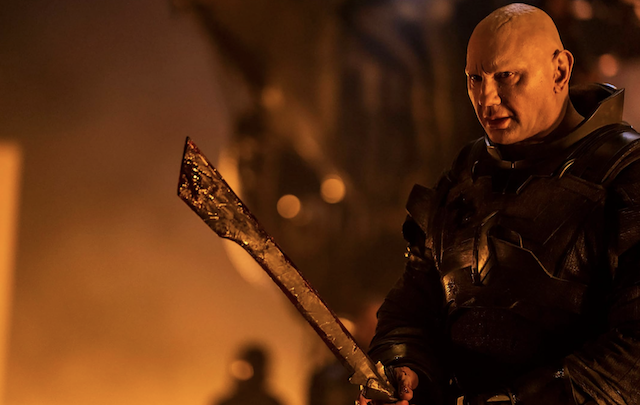 Photo by Niko Tavernise/Niko Tavernise – © 2022 Warner Bros. Pictures,
Photo by Niko Tavernise/Niko Tavernise – © 2022 Warner Bros. Pictures,
Q : Can you talk about your working relationship with cinematographer Greg Frazier? How did you build the visual style that had already been established in Part One and how did you expand that in Part Two?
Denis Villeneuve: We both knew that the second movie would be much more ambitious. The first one was more contemplative, more meditative. Before we were following a boy who discovers a culture, a new planet and who is a victim of the events. He is a survivor In the second movie, Paul takes action, becomes a man, becomes a fighter.
Dune: part Two is a war movie so I knew that there would be a different rhythm to the film. It would be more muscular. The desert was meant to be an important setting, in order to feel that kind of energy that I was looking for in the characters. With Greg, the thing I absolutely adore with him is that he, like me, didn’t want to compromise.
I’m saying this because we were using natural light exclusively. It was very important for me and I went to Greg Fraser because I love how he uses sunlight. It created a real puzzle in the schedule because most of the scenes in the desert were sometimes shot in different locations, according to the sun and the specific dramatic quality that was looking in the landscape. In Part Two sometimes it was 12 or 14 different locations.
So it created a very complex puzzle, it was challenging for my first assistant director, but it was quite rewarding when we saw the final result in the editing room. Greg used software in order to predict the sun’s direction. For example if you shoot around a rock and there will be a battle sequence around that rock, Greg will capture in a virtual environment the rock and the all topography around and then put that in the computer and calculate the angle of the sun according to a specific day.
So we knew the sun would be there at the time so we had to land there earlier in order to put a camera out there at the right position, so the sun would be at 15 degrees and the actors would… It was all like that. So it was very playful, but very intense.
Q : Was there a set in Dune: Part Two that you walked into and was like, “Oh my gosh, we built this world..”?
Denis Villeneuve: Each of them were quite stunning and jaw dropping, frankly, because of the size and because of the level of precision of the details. If you walked into the beach, for instance, it was grandiose. It was like walking into a cathedral, a huge church. But at the same time, if you got close to the walls, you were seeing all the writing of the Fremen prophecy, that was actually a real language that Patrice and David Peterson had worked on, that meant something.
The production design was quite impressive. My favorite set was a cave of birds: It’s like a natural formation that Patrice recreated outside in Budapest and it was very poetic. You felt that you were inside the skeleton of some kind of huge animal. By far, the most poetic place I’ve been in as a filmmaker.
Q : How does Dune: Part Two explore the issue of good against evil and how easily can we see our own world in those pursuits your characters are put through?
Denis Villeneuve: I always try to bring some kind of nuance on screen. I hope that things are not black and white, that things are more nuanced. Pure evil exists, but it’s rare. Most of the time it’s a matter of perspective. Of course no one will question that Baron Harkonnen is evil, but if you take a character like the Emperor, he is someone that is squeezed with political games and makes very bad decisions.
But is he pure evil? I’m not sure about that. He is a technocrat and a coward. When Frank Herbert wrote the first book, he had some very precise intentions. He wanted the book to be seen as a cautionary tale, a warning toward Messianic figures. And he was disappointed how the book was perceived when it was released.
He wanted Paul to be an anti-hero. So in order to correct that perception, he wrote a second book called Dune Messiah, a tiny book that is a kind of epilogue that tried to correct the perception of the first book. So I tried to make this adaptation closer to Frank Herbert’s initial intentions. Dune: Part Two is a warning. It’s not a celebration of Paul, who becomes something that he condemned.
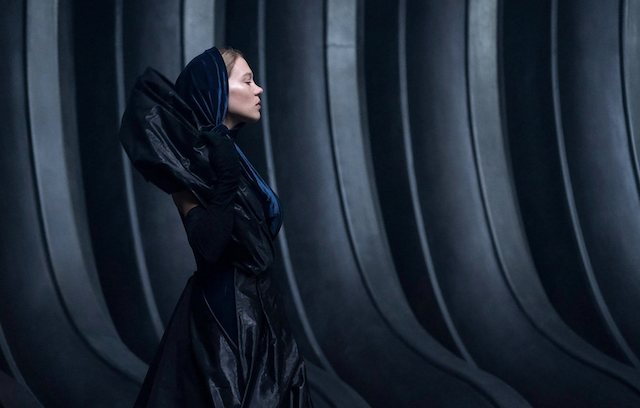 Photo by Niko Tavernise – © nikotavernise.com
Photo by Niko Tavernise – © nikotavernise.com
Q : As a director, what has been the most rewarding aspect of working on the Dune project so far, and how has it evolved or changed your approach to filmmaking going forward?
Denis Villeneuve: I just finished the movie, I’m still digesting. I felt that at specific moments doing Part Two, I thought: “Okay, in the next project, that’s where I need to go.” And it’s something that always amazes me.
It’s like a sculpture. You sculpt and suddenly you see an opportunity and you discover something in the practice that you could actually improve as a filmmaker. And I feel that each movie brought me forward and there’s always this idea that you can be better. I mean, it’s what brings the necessary fuel to make another movie, I guess.
Q : What do you think it is about the story of Dune that has made it so popular for all these decades and loved by audiences?
Denis Villeneuve: I think that the identity quest is something that’s quite moving. The fact that a boy will finally find a home and consolidate his identity in another culture. It’s also a book that brings a lot of hope with the idea of the human spirit. The idea is to improve humanity instead of improving machines is something that is a message of hope and quite a powerful message.
And there’s also the exploration of the impact of the ecosystem on human beings: how we are related to the ecosystems and how we should reestablish this notion, the sacred quality of our relationship with nature. Instead of trying to dominate nature, to be in harmony with nature and respecting nature as the Fremen do, I think it’s something that speaks a lot to the youth.
Check out more of Adriano’s articles.
Here’s the trailer of the film.

